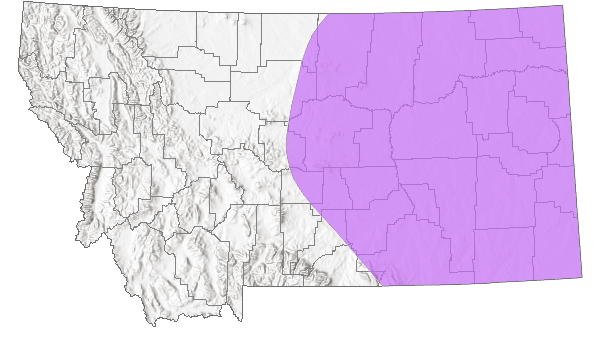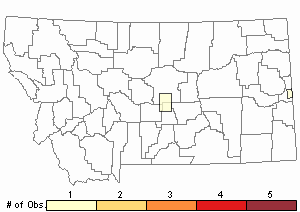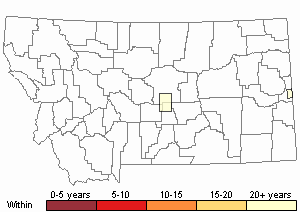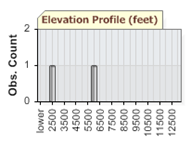View in other NatureServe Network Field Guides
NatureServe
Montana
Utah
Wyoming
Idaho
Wisconsin
British Columbia
South Carolina
Yukon
California
New York
Armed Snaggletooth Snail - Gastrocopta armifera
Other Names:
Pupa armifera, Bifidaria armifera
General Description
A small shell, to about 2.2 mm diameter and 4.5 mm in height, subcylindrical (pupiform) and tapering with weak irregular striae, about 6 1/2 whorls. Shell coloration translucent white. Aperture rounded to subovate, with 6 teeth (denticles: forked parietal, columellar, subcolumellar, lower palatal, upper palatal, suprapalatal), palatal callus present, sinulus absent, lip thin and flared (Hendricks 2012). Internal anatomy is described by Pilsbry (1948).
Diagnostic Characteristics
Shape (pupiform) and color (transparent whitish), with teeth in the aperture distinguish Gastrocopta from similar sized and shaped shells (Pupilla, Vertigo, Columella). G. armifera is the largest (height > 3.5 mm, diameter > 2.0 mm) with 6 teeth in aperture. Both G. holzingeri and G. pentadon are about 2.0 mm in height and 1.0 mm in diameter. G. holzingeri has a parietal tooth forked and shaped like the Greek letter lambda and a columellar tooth curving downward (basally) within aperture; the parietal tooth of G. pentodon is not lambda-shaped and the columellar tooth does not curve downward within the aperture.
Species Range
Montana Range
Range Descriptions

 Native
Native
Range Comments
Eastern Canada and the United States south to Florida and west to Alberta, Texas and New Mexico. In Montana, reported east of the Continental Divide from two counties: Golden Valley (“Snowy Mountains”), Wibaux. Elevation range is 823 to 1829 m (2700 to 6000 ft). The Golden Valley County (“Snow Mountains”) location is a guess, and might actually be in Wheatland County along the Musselshell River at Winnecook, where Stillman Berry collected in 1911, which is the date of the “Snow Mountains” collection attributed to V. Sterki. Four individuals were collected at the site. Range and abundance in Montana are poorly documented; current status needs investigation (Hendricks 2012).
Observations in Montana Natural Heritage Program Database
Number of Observations: 2
(Click on the following maps and charts to see full sized version)
Map Help and Descriptions
Relative Density

Recency



 (Observations spanning multiple months or years are excluded from time charts)
(Observations spanning multiple months or years are excluded from time charts)
Habitat
Not described for Montana; ponderosa pine and Rocky Mountain juniper woodland on rocky outcrops adjacent to water in Wyoming. Found in arid sites under woody debris (logs) (Hendricks 2012).
Stewardship Responsibility
References
- Literature Cited AboveLegend:
 View Online Publication
View Online Publication Hendricks, P. 2012. A Guide to the Land Snails and Slugs of Montana. A report to the U.S. Forest Service - Region 1. Montana Natural Heritage Program, Helena, MT. vii + 187 pp. plus appendices.
Hendricks, P. 2012. A Guide to the Land Snails and Slugs of Montana. A report to the U.S. Forest Service - Region 1. Montana Natural Heritage Program, Helena, MT. vii + 187 pp. plus appendices. Pilsbry, H.A. 1948. Land Mollusca of North America (north of Mexico), Volume II Part 2. The Academy of Natural Sciences of Philadelphia Monograph Number 2(2): 521-1113.
Pilsbry, H.A. 1948. Land Mollusca of North America (north of Mexico), Volume II Part 2. The Academy of Natural Sciences of Philadelphia Monograph Number 2(2): 521-1113.
- Additional ReferencesLegend:
 View Online Publication
View Online Publication
Do you know of a citation we're missing? Beetle, D.E. 1989. Checklist of recent Mollusca of Wyoming, U.S.A. The Great Basin Naturalist 49(4):637-645.
Beetle, D.E. 1989. Checklist of recent Mollusca of Wyoming, U.S.A. The Great Basin Naturalist 49(4):637-645. Berry, S.S. 1913. A list of Mollusca from the Mussellshell Valley, Montana. Nautilus 26:130-131.
Berry, S.S. 1913. A list of Mollusca from the Mussellshell Valley, Montana. Nautilus 26:130-131. Nekola, J.C. and B.F. Coles. 2010. Pupillid land snails of eastern North America. American Malacological Bulletin, 28(2):29-57
Nekola, J.C. and B.F. Coles. 2010. Pupillid land snails of eastern North America. American Malacological Bulletin, 28(2):29-57 Squyer, H. 1894. List of shells from the vicinity of Mingusville, Montana. The Nautilus 8:63-65.
Squyer, H. 1894. List of shells from the vicinity of Mingusville, Montana. The Nautilus 8:63-65.
- Web Search Engines for Articles on "Armed Snaggletooth Snail"
- Additional Sources of Information Related to "Snails / Slugs"





